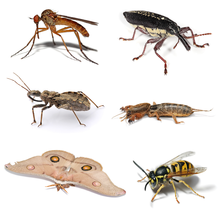
Back Insek Afrikaans Insekten ALS ሦስት አጽቄ Amharic Insecta AN Ceorfdēor ANG कीट ANP حشرة Arabic ܪܚܫܐ ARC حشره ARZ পতংগ Assamese
| Insecta Temporal range: Ordovician ~479 mya to present [1]
| |
|---|---|

| |
| Clockwise from top left: dance fly, long-nosed weevil, mole cricket, wasp, emperor gum moth, assassin bug | |
| Scientific classification | |
| Domain: | Eukaryota |
| Kingdom: | Animalia |
| Phylum: | Arthropoda |
| Clade: | Pancrustacea |
| Subphylum: | Hexapoda |
| Class: | Insecta Linnaeus |
| Subgroups | |
| Synonyms | |
| |
Insects are a class in the phylum Arthropoda.[2] They are small terrestrial invertebrates which have a hard exoskeleton.
Insects are the largest group of animals on Earth by far: about 926,400 different species have been described.[3] They are more than half of all known living species.[4][4][5][6][7] They may be over 90% of animal species on Earth.[8]
New species of insects are continually being found.[9] Estimates of the total number of species range from 2 million to 30 million.[3]
All adult insects have six legs; and most have wings. Insects were the first animals capable of flight. As they develop from eggs, insects undergo metamorphosis. Insects live all over the planet: almost all are terrestrial (live on land). Few insects live in the oceans or in very cold places, such as Antarctica. The most species live in tropical areas.
Some people call all insects "bugs", but this is not correct. Only some insects are true bugs, which is a particular order of insects. People who study insects are called entomologists.
- ↑ Misof B. and others 2014. Phylogenomics resolves the timing and pattern of insect evolution. Science 346 763-767. [1] doi:10.1126/science.1257570
- ↑ Or, if the Arthropods are regarded as a superphylum, then the Insecta is a phylum.
- ↑ 3.0 3.1 Grimaldi D. and Engel M.S. 2005. Evolution of the insects. Cambridge University Press. 11–15: How many species of insects? ISBN 0-521-82149-5
- ↑ 4.0 4.1 Chapman A.D. (2006). Numbers of living species in Australia and the World. Canberra: Australian Biological Resources Study. ISBN 978-0-642-56850-2. Archived from the original on 2009-06-09. Retrieved 2015-11-08.
- ↑ Wilson, E.O. "Threats to global diversity". Archived from the original on 20 February 2015. Retrieved 17 May 2009.
- ↑ Novotny, Vojtech; et al. (2002). "Low host specificity of herbivorous insects in a tropical forest". Nature. 416 (6883): 841–844. Bibcode:2002Natur.416..841N. doi:10.1038/416841a. PMID 11976681. S2CID 74583.
- ↑ Erwin, Terry L. (1997). Biodiversity at its utmost: tropical forest beetles. pp. 27–40. In: Reaka-Kudla M.L; Wilson D.E. and Wilson E.O. (ed.). Biodiversity II. Joseph Henry Press, Washington, D.C.
{{cite book}}: CS1 maint: multiple names: editors list (link) - ↑ Erwin, Terry L. (1982). "Tropical forests: their richness in Coleoptera and other arthropod species". Coleopt. Bull. 36: 74–75.
- ↑ Hall, Derek 2005. Encyclopedia of insects & spiders. Grange Books. ISBN 1-84013-793-2 / 1-84013-793-2
© MMXXIII Rich X Search. We shall prevail. All rights reserved. Rich X Search